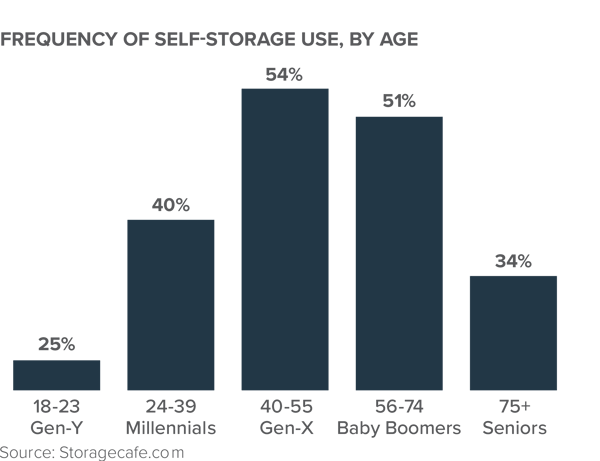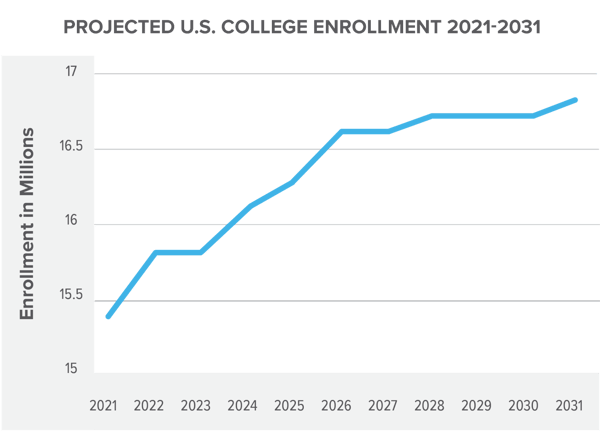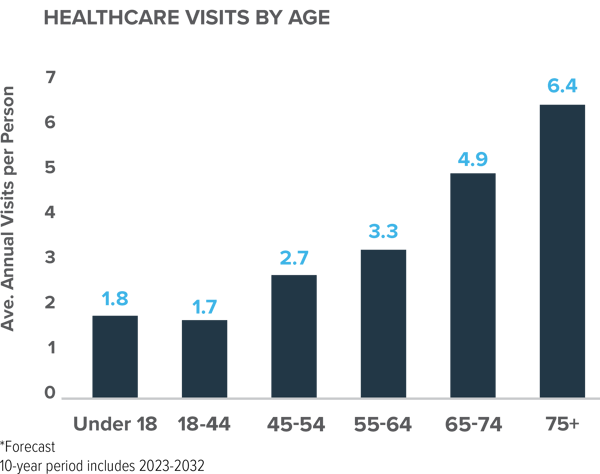The landscape of commercial real estate is shifting. Astute financial professionals and investors are paying close attention.
What's behind this transformation? An ever-changing tapestry of demographic trends that are shaping the future of commercial real estate.
In this blog, we'll delve into the sectors benefiting from these evolving demographic demand drivers and explore how financial professionals and investors can leverage these trends for success.
There are five key, niche sectors benefiting from demographic trends and the resulting potential growth:

1. Self-Storage
The need for self-storage arises from life changes and events. Whether moving, downsizing, or needing extra space for home or business, Americans increasingly use self-storage:
-
Retirees, a significant and growing demographic group, are downsizing but may still need storage for a lifetime of possessions.
-
The booming e-commerce industry requires storage for inventory.
-
The pandemic drove a shift to remote work for many Americans, with a trend of converting a portion of their home into an office or adding a home gym. The work-from-home movement has endured, providing further support for the self-storage industry.
Approximately 38 percent of Americans, or 44 million U.S. households, rent a self-storage unit.1 All ages use self-storage, however, gen-xers and baby boomers are most likely to store belongings in a storage unit, with over half of each generation using self-storage:

2. Student Housing
We believe the student housing sector is on the rise, fueled by increasing student enrollment and the growing international student population. Understanding the demographics of the student population is crucial for investors in this sector.
According to the Association of Public Land Grant Universities:
“The evidence that a college degree significantly improves one’s employment prospects and earnings potential is overwhelming. Bachelor’s degree holders are half as likely to be unemployed as their peers who only have a high school degree and they make $1.2 million in additional earnings on average over their lifetime.” 2
We believe that student awareness of these economic realities drives enrollment in higher education nationally. In turn, this drives demand for student housing, particularly near leading universities. Students today are seeking off-campus housing with enhanced safety and amenities, supporting growth in this sector. The National Center for Education Statistics notes that college enrollment is expected to increase by 9 percent from 2021 to 2031 for a total of 16.8 million students.3

3. Senior Housing
An aging baby boomer generation drives growth in the senior housing sector. Senior housing options also include healthcare-oriented facilities and services, such as assisted living and memory care. In our experience many of today's seniors favor senior living communities that offer various amenities and services.
The number of Americans over age 65 is forecasted to grow by 14.6 million or 25 percent over the next decade.4 This demographic trend will likely reshape the senior housing market.

4. Medical Office Buildings
An aging population is also leading to increased healthcare demand, and we believe that medical office buildings benefit, too. With a shift towards outpatient care, these buildings are in high demand.
The need for healthcare services increases as we age. The number of healthcare visits per year nearly quadruples from under 1.7 for young adults to 6.4 for those 75 and older.5

By 2060, nearly one in four Americans will be 65 years old or older. We expect that an aging population of 70 million baby boomers in their 60s and 70s will drive increasing demand for medical services, sustaining the medical office building sector.
5. Manufactured Housing Communities
A national shortage of affordable housing drives demand for manufactured housing communities. This alternative real estate sector appeals to first time home buyers and young families as well as to downsizing retirees seeking a lifestyle change.
With the housing affordability crisis affecting many parts of the country, these communities provide an appealing solution. Manufactured housing offers one of the largest sources of unsubsidized affordable housing in the United States and provides shelter to more than 22 million Americans with a median annual income of around $35,000.6 Nevertheless, manufactured housing only accounts for 10 percent of the nation’s total housing stock,7 which we see as evidence of the growing need for affordable housing options and the tailwinds supporting the sector.
The fast-growing SunBelt is the principal location for manufactured housing communities.8 Many of the communities in these states are near beaches, mountains, and state parks, offering a rewarding lifestyle.

Combining Demographic Insights with Local Analysis
Understanding and leveraging these overarching demographic trends is valuable. However, local factors play a significant role in determining the success of individual properties. Combining broad demographic research with local analysis is key.
Capitalizing on Change
We believe that demographic trends are powerful drivers of change in the commercial real estate market. We also believe that sectors like self-storage, student housing, senior housing, medical office buildings, and manufactured housing communities can thrive due to changing population dynamics. Financial professionals and investor who capitalize on these trends can benefit from the potential of these high-demand real estate sectors.
Learn More
Visit our website to explore more about the opportunities in these emerging real estate sectors.
Sources
1. More Than a Third of Americans Rent Self Storage, August 15, 2022, storagecafe.com
2. How does a college degree improve graduates’ employment and earnings potential? aplu.org
3. NCES Undergraduate Enrollment; May 2022 nces.gov
4. Best CRE Property Types On A 5-Year Horizon, January 23, 2023, youtube.com, Marcus & Millichap Research Services, U.S. Census Bureau, Moody’s Analytics
5. Best CRE Property Types On A 5-Year Horizon, January 23, 2023, youtube.com, Marcus & Millichap Research Services, U.S. Census Bureau, Moody’s Analytics
6. Manufactured Housing Institute. Benefits of Living in a Manufactured Housing Community. Accessed January 2023.
7. Manufactured Housing Institute. Affordable Housing Solution: Manufactured Homes. Accessed January 2023.
8. Statista. Number of manufactured housing units in selected states in the United States as of December 2021.
The views expressed herein are subject to change based upon economic, real estate and other market conditions. These views should not be relied upon for investment advice. Any forward-looking statements are based on information currently available to us and are subject to a number of known and unknown risks, uncertainties and factors which may cause actual results, performance or achievements to be materially different from any future results, performance or achievements expressed or implied by these forward-looking statements.
Some of the risks related to investing in commercial real estate include, but are not limited to: market risks such as local property supply and demand conditions; tenants’ inability to pay rent; tenant turnover; inflation and other increases in operating costs; adverse changes in laws and regulations; relative illiquidity of real estate investments; changing market demographics; acts of God such as earthquakes, floods or other uninsured losses; interest rate fluctuations; and availability of financing.



